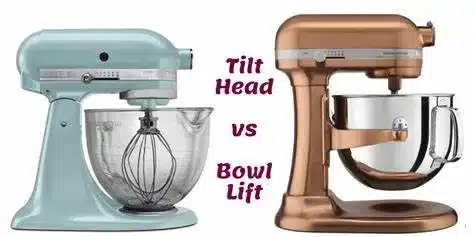
KitchenAid stand mixers are beloved kitchen appliances known for their power, versatility and durability. With the mixer market saturated with options, one of the biggest decisions is whether to get a tilt-head or bowl-lift model. But which one is right for you? This guide will compare the key differences and help you determine if a tilt head or bowl lift KitchenAid mixer is the best fit.
Tilt head mixers feature a motor head that tilts back, allowing you to easily attach and detach bowls and accessories. The head locks into place while mixing. Popular tilt head models include the KitchenAid Artisan, KitchenAid Professional 600, and mini mixers.
Bowl lift mixers have a motor head that remains stationary. The bowl lifts up and down on a lever to attach to the mixing head. Common bowl lift models are the KitchenAid Professional 5 Plus, Professional 6, and Commercial 8.
Both styles have the same power capacity on standard models ranging from 275 watts for mini mixers to 1.3 horsepower for larger capacity commercial mixers. The difference lies in the mixing head mechanism and bowl insertion design.
Here are some key considerations when deciding between a tilt head or bowl lift KitchenAid mixer:
Tilt head mixers are generally simpler to operate, especially for beginners. The head tilts back easily with the flip of a lever, allowing you to insert or remove the bowl. With bowl lift mixers, you need to crank the bowl upwards manually, which can be challenging when a heavy mixture is inside.
Tilt head mixers also feel more nimble and less bulky when moving them around or storing since the bowl can be detached. The integrated head and bowl on a bowl lift model makes it heavier.
Bowl lift mixers offer more stability with their immobile motor head and lever-operated bowl. The bowl locks securely into place, keeping it steady during intense mixing tasks. Bowl lift models are ideal for dense mixtures like bread dough that require vigorous kneading.
Meanwhile, tilt head mixers rely solely on the head locking mechanism to keep the bowl stable. Over time, this can loosen with frequent use. Tilt head mixers work best for lighter mixing tasks like cake batters, although models like the Professional 600 are quite robust.
Tilt head mixers have a smaller footprint, taking up less counter space. Their lightweight and compact build makes them easier to store away in cupboards compared to heftier bowl lift models. The detachable bowl is also simpler to keep separate.
Bowl lift mixers have larger bases that securely house the motor and gears. Their taller bowl lift design needs overhead clearance. The integrated bowl and head takes up more storage room.
Tilt head mixers generally have a lower price point since their mechanism is simpler to manufacture. The popular KitchenAid Artisan tilt head mixer costs around $280 – $430.
Bowl lift mixers utilize more complex gear assemblies and robust lifting mechanisms, making them pricier. The KitchenAid Professional 5 Plus usually starts around $429 – $549. However, the durability and performance gains can make bowl lift mixers worthwhile for avid bakers and cooks.
Tilt head mixers come in a wider variety of colors to suit different kitchen aesthetics. Their cohesive and sleek look appeals to many home bakers.
Bowl lift mixers usually have more neutral, traditional finishes like white, black or silver. Their utilitarian appearance shows they mean business! Some food enthusiasts also enjoy displaying the mechanical workings.

Tilt head KitchenAid mixers are ideal choices for:
Bowl lift KitchenAid mixers excel at:
While both mixers deliver outstanding performance, tilt head models are ideal for lighter tasks, convenience and affordability, while bowl lift mixers provide extra stability and strength for heavy mixing.
Think about your budget, mixing needs, kitchen space and convenience before deciding. Home cooks aiming for more simplicity may find tilt head mixers fulfilling their needs, while passionate bakers and cooks who make large batches or dense mixtures can benefit from the sturdy bowl lift design.
Whichever style you choose, KitchenAid makes high-quality, long-lasting stand mixers that will elevate your cooking abilities for years to come. With the proper care and maintenance, your KitchenAid mixer can handle thousands of recipes with ease. Let your new mixer guide you on sweet and savory adventures in the kitchen!
What is the difference between a KitchenAid Artisan and Professional model?
The Artisan is a tilt head mixer with a 275 watt motor ideal for most home baking tasks, while the Professional is a more powerful bowl lift version (325-575 watts) made for intensive mixing. Professional models have stronger motors and larger bowl capacity.
Can all KitchenAid attachments work on both mixer types?
Yes, all standard KitchenAid attachments like the wire whip, dough hook and flat beater are interchangeable between tilt head and bowl lift mixers. Specialty attachments like food grinders or pasta rollers should specify mixer compatibility.
How long do KitchenAid mixers last?
With proper maintenance, KitchenAid mixers typically last 15-20 years, and often longer. Their all-metal gears and powerful motors are built to endure years of regular mixing. Both tilt head and bowl lift styles have similar longevity.
With a wide range of models to choose from, KitchenAid makes a stand mixer suitable for just about any home chef. Whether you value convenience and affordability in a tilt head mixer or the advanced strength of a bowl lift, both allow you to tackle recipes with ease. Your KitchenAid mixer will be a faithful assistant in the kitchen for many years to come.
